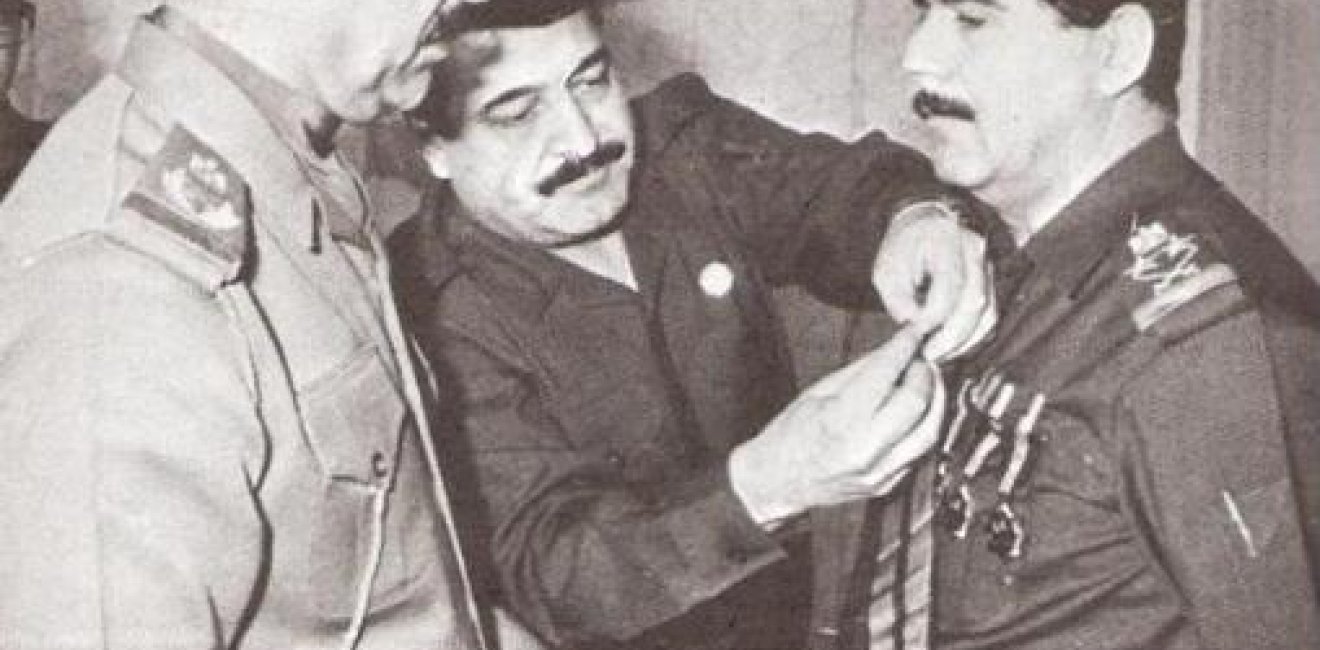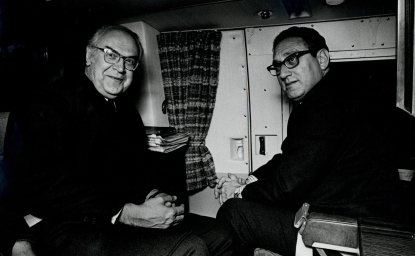A New Release from the Saddam Files: Chemical Weapons, Sanctions, and Family Turmoil
Michael Brill introduces the next batch of documents from the Saddam Files Collection, donated to the Wilson Center by author Steve Coll.

A blog of the History and Public Policy Program
Michael Brill introduces the next batch of documents from the Saddam Files Collection, donated to the Wilson Center by author Steve Coll.

Explore MORE FROM the saddam files
This installment of the Saddam Files introduces nearly 300 pages of original Arabic documents that were captured during the 2003 Iraq War and accompanying English translations, along with the transcripts and translations for ten audio tapes of Saddam Hussein’s meetings. These disparate materials were organized and consolidated into twenty files that were part of the archive previously available at the Conflict Records Research Center. Part of the archive was obtained by Reporters Committee for Freedom of the Press and Steve Coll in a settlement with the US Department of Defense and later donated by Coll to the Wilson Center’s History and Public Policy Program.
Iraqi chemical warfare was a grim, iconic feature of the 1980-1988 Iran-Iraq War. As the conflict dragged on, Iraq’s use of chemical weapons became more extensive and sophisticated.
This post introduces two files and one audio tape related to chemical warfare that were recently added to the Saddam Files on the Wilson Center Digital Archive. The first is a Ministry of Defense file containing correspondence about a June 27, 1985, training exercise during which Iraq gassed one of its own units, unbeknownst to the frontline soldiers exposed to the poison. With the exercise carried out for the purpose of “overcoming the psychological barrier to chemical weapons exposure,” the report notes the circulation of the rumor among Iraqi troops that such weapons “may possibly be used by the enemy.” While this might have reflected anxieties that the Islamic Republic of Iran would act on its threats to build and use chemical weapons against Iraq in kind, the exercise, which was officially deemed a success, was likely based on more immediate and practical considerations.
Revealingly, one after-action report mentions that members of the unit suspected that they had been exposed to Iraqi chemical weapons, which had been carried by the wind back from Iranian lines, a common enough occurrence in the conflict by that point. As the Iran-Iraq War entered its latter stages, and Iraq dramatically increased its use of chemical weapons, even incorporating them into its combined arms strategy for offensive operations, this kind of training exercise remained relevant.
The second file is from 1987 and shifts to northern Iraq, where the Iraqi military was battling both Iranian military units and Peshmerga fighters of the Patriotic Union of Kurdistan (PUK) under Jalal Talabani. The file contains plans from the General Military Intelligence Directorate related to chemical strikes using Iraqi artillery, helicopters, and aircraft. In targeting the more remote mountain bases used by Iranian and Iraqi Kurdish forces, one diplomatic consideration was the use of chemical weapons in proximity to Iraq’s international border with Turkey. Another consideration was geography and the expressed preference for low-lying targets, where poison gas would be more effective.
Noting that Iraq was facing shortages in its chemical weapons stockpiles, undoubtedly related to its extensive use of them by this stage in the war, one report recommended the use of mustard gas with ricin since winter conditions were unsuitable for the use of tabun and sarin nerve gas. In an undated audio recording, likely of a meeting that took place during the late-1980s, Saddam boasts of Iraq’s chemical weapons capability and suggests that they should share this knowledge with the Arab world, stating, “It is impossible for all the Arabs to have… to have reached the stage we did as far as quantity and quality… it is happening by tons.”
Other records provide valuable insights into Saddam’s view of developments in the Iran-Iraq War. In one meeting with military commanders, Saddam strikes an upbeat tone when discussing Iran’s southern offensive, explaining that even if Iranian forces were to capture Basra, “it wouldn’t be the end of the world.”
The same tape provides insight on the subsequent Anfal campaigns in northern Iraq, where Saddam mentions that his cousin Ali Hassan al-Majid had been given full authority to take military actions as needed, eliminating the need for constant communication with Baghdad.
Following the end of the Iran-Iraq War and the completion of the Anfal campaigns, Saddam and his advisers discussed northern Iraq through a modernization theory-like lens, articulating a kind of Baʿthist civilizing mission, especially with respect to the region’s restive Kurdish population. Saddam declared, “it becomes our responsibility to he who lives by the gun for a long time and is accustomed to it, to instead teach him to work, step by step.”
Another meeting was recorded in the aftermath of the May 17, 1987, accidental Iraqi attack on the USS Stark, which killed 37 and wounded 21 and occurred against the backdrop of the “tanker war” between Iraq and Iran. Along with a general sense of relief that the American diplomatic response had been “balanced and normal,” Saddam and his advisers discussed increased coordination with the United States to ensure that a similar mistake did not take place again.
In a 1988 meeting, after Iraq’s decisive recapture of the Faw peninsula, Saddam and his military commanders discussed recent American naval operations in the Gulf against Iran, along with the proximity of the US Navy to the Faw peninsula during Iraq’s operations to recapture it, which they viewed with suspicion.
Even as the bloody Iran-Iraq War neared its conclusion, Saddam remained fearful of its further internationalization. In the same meeting Saddam described Libyan dictator and Iranian ally Muammar al-Ghaddafi as “bipolar,” he also stated, “the situation is dangerous. Any spark right now could cause a world war.”
Saddam’s alarmist thinking had been bolstered by the revelation of the Iran-Contra scandal in November 1986, a development he interpreted as confirming his suspicions that Iran, Israel, and the United States had been conspiring against him and Iraq all along. After “Irangate,” as Saddam and his inner circle called the scandal in a homage to Watergate, past failures of US intelligence to warn Iraq against Iranian offensives were viewed as part of the plan to help Iran win the war. During an undated meeting that likely took place in late-1988, Saddam expressed the opinion that a recent assassination attempt against him had been the handiwork of the Central Intelligence Agency (CIA). As he told those gathered, “It is—my conviction. I don't have information. Nobody told me. I have a strong feeling that they were behind it.”
Saddam’s view of the CIA as omnipotent permeated every level of the Baʿth Party and its intelligence services. A 1986 study prepared by the General Military Intelligence Directorate on US intelligence agencies explained, “Every project conducted by the Americans outside of America is conducted by the CIA.”
Saddam’s perceptions of enemies conspiring against him directly influenced his decision to invade Kuwait on August 2, 1990. In a later meeting with officials he said, “America had decided to attack Iraq before August 2nd,” and in another announced, “the main battle started before Kuwait… What happened on 8/2 was a reaction to this sweeping plan. America wants to control the whole region together with Israel and do whatever is to their liking. Iraq had uncovered this plan very clearly.” Saddam’s fear of the CIA only grew as Iraq came into direct military conflict with the United States. In February 1991, the General Military Intelligence Directorate forwarded reports that CIA and Israeli Mossad teams had infiltrated Baghdad to assassinate Saddam and the Baʿth Party’s leadership.
After Saddam remained in power despite Iraq’s disastrous military defeat in Kuwait that sparked internal uprisings, events years later were seen in similar terms, for both real and imagined reasons. Aware of the fact that the U.S.-led coalition had targeted him during the air campaign of Operation Desert Storm, Saddam was unaware but could have imagined that President George H.W. Bush also issued a directive to the CIA to work toward the overthrow of his regime. In 1995, after two American defense contractors working in Kuwait accidentally crossed the border into Iraq and were detained, Iraqi intelligence viewed the incident as a potential pretext for the United States to attack Iraq or assassinate Saddam. Despite Iraq’s heavy losses in the 1990-1991 Gulf War, in another meeting from this period, Saddam claimed the Iraqi military was stronger for having survived the US-led coalition onslaught. In a 2000 speech urging Iraqis to prepare for renewed conflict with the United States he declared, “the goal of the enemies has become clear after ten years of war and ten years of blockade.”
This third batch of records also contains documents from the period of international sanctions against Iraq between the 1991 and 2003 wars.
The most interesting is a Presidential Diwan file containing the minutes of a February 4, 1998, meeting between Iraqi and French officials. Leading the French delegation as President Jacques Chirac’s personal envoy, Bertrand Fort delivered a letter from the president to Saddam and explained, “I met with Mr. Jacques Chirac on Monday morning; he asked me to deliver the letter to you personally… He currently considers France to be the country trying to alleviate the American pressure, and provide the most possible assistance to Iraq.”
The United Nations Oil-for-Food Program, established three years prior in 1995, had ostensibly allowed Iraq to sell oil on the international market in exchange for humanitarian supplies. In practice, the program became a major conduit for corruption that Saddam’s regime exploited to its advantage. Nevertheless, Iraq’s coffers were still tied to the price of oil. In light of US lobbying for the Organization of the Petroleum Exporting Countries (OPEC) to increase production, a September 2000 proposal from Ja’far Dhia Ja’far, a presidential adviser who was previously the father of Iraq’s nuclear weapons program, advocated for Iraq to correspondingly cut oil production to stabilize the price .
Finally, this release features two letters f rom Saddam’s half-brother Barzan al-Tikriti, who after running the Mukhabarat as Saddam and the Baʿth Party consolidated power, later fell out of favor and went abroad to become Iraq’s representative to the United Nations in Geneva, Switzerland. Despite being written by Barzan and sent to Saddam nearly a decade apart, both letters report incidents and include complaints about the behavior of Saddam’s troublesome and murderous son Uday.
As in the case with the other records introduced here, readers of Steve Coll’s The Achilles Trap will recognize the appearance of their contents in the book’s narrative and can reference them with the endnote citations included with the metadata for each.

A leader in making key foreign policy records accessible and fostering informed scholarship, analysis, and discussion on international affairs, past and present. Read more


